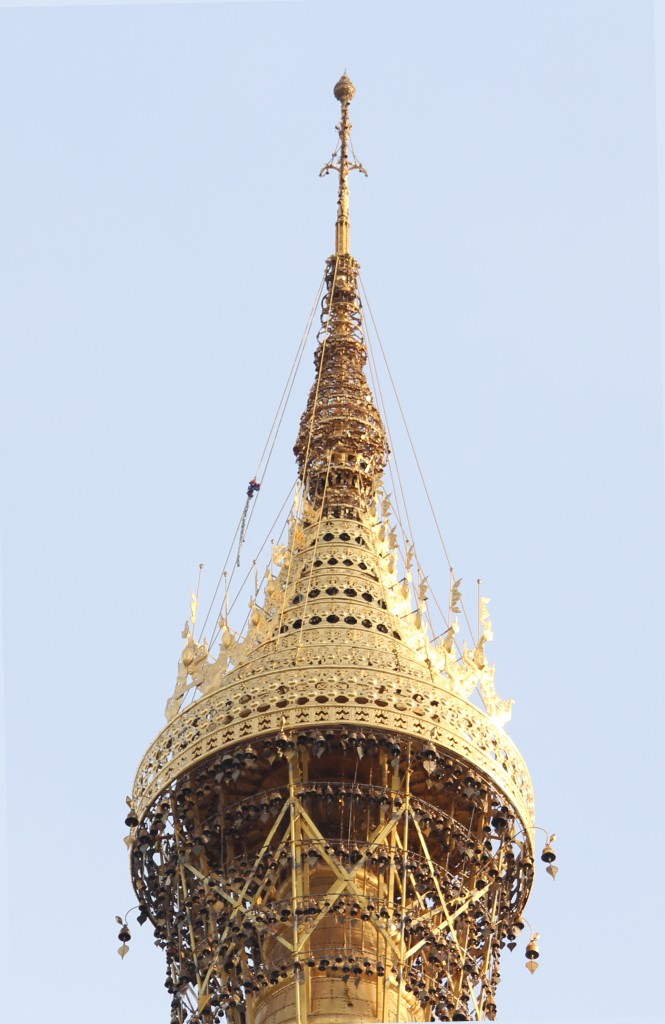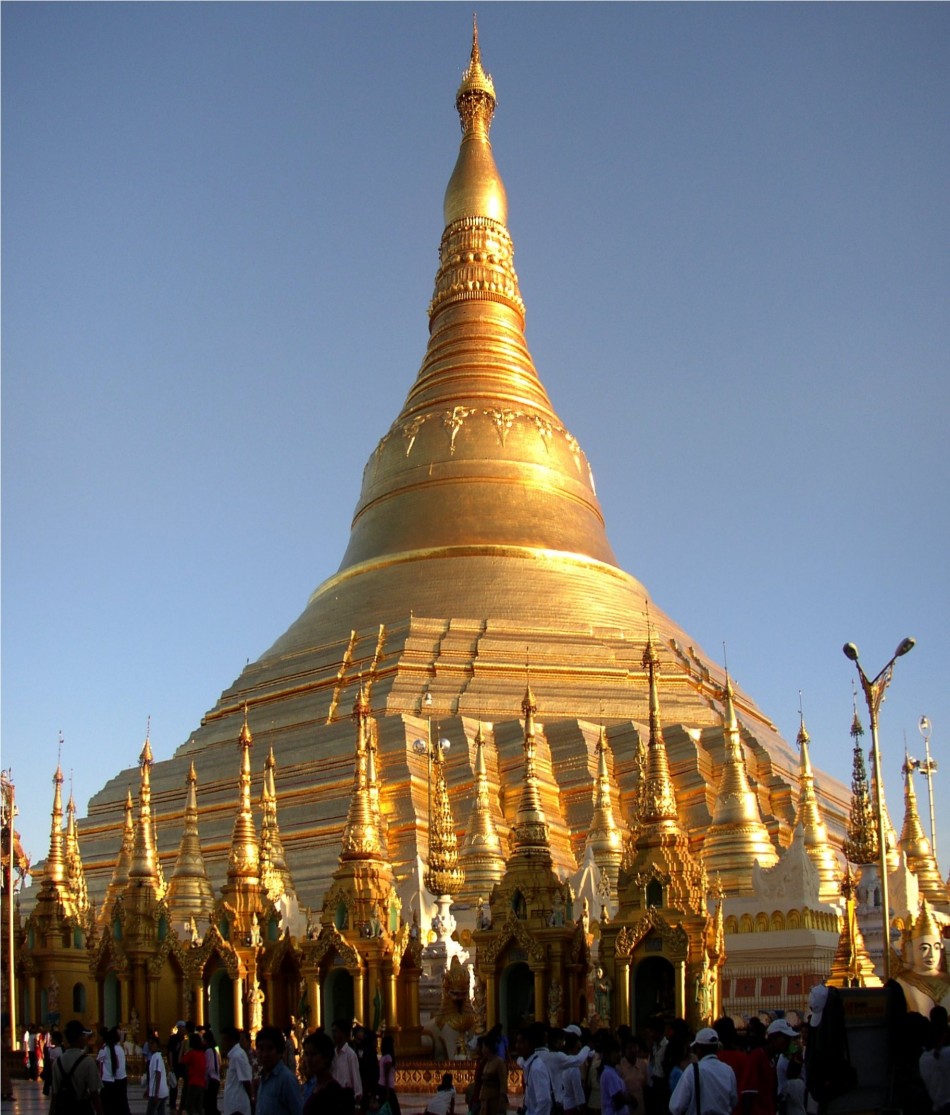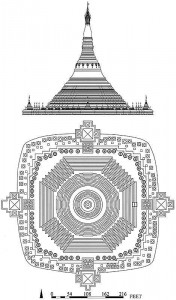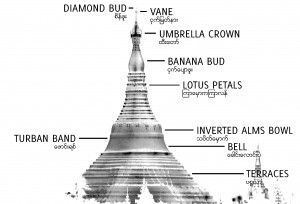Shwedagon Pagoda (aka Great Dagon Pagoda or Golden Pagoda). Yangon, Myanmar. © Ralf-André Lettau with permission.
According to this source:
Stupas assume many roles, also outside religion. Most of them were built as vote offerings, since it is a need of human to ask someone for something. Others serve as signposts and protect the travelers from bad adventures. They can be fragments of battlements or pilgrims’ destinations as the legendary Swayambhu Stupa, which, as the legend says, has existed from time immemorial.
Swayambhu reflects one of the Buddhist universe symbolisms, which is made of a basic rock – the hill that makes the basis of the Stupa. It is also a part of the building, which symbolizes the embryo, the beginning of life. All this is joined by the axis of Universe – the central trunk of the tree of life, which is based on the rock. As the legend says, once the whole Kathmandu valley was flooded and only Swayambhu Stupa stuck out of the water.
(…) Stupas are energy generators, which is initiated during a beautiful ceremony of placing the Tree of Life in the central channel of the Stupa. A wooden pole is covered with gems, thousands of mantras and colorful ribbons which are handed to all the participants in the initiation. When it’s signaled everyone makes the best and strongest wishes which travel along the silk “motorway” and are stored in a Tree of Life. The “battery” that has been charged with proper energy is then placed in the Stupa.
- L. H. Phuoc, Bhuddist Architecture, Grafikol, 2010.
[Bibtex]@Book{Phuoc2010, title = {Bhuddist Architecture}, publisher = {Grafikol}, year = {2010}, author = {Le Huu Phuoc}, month = {may}, note = {The volume thoroughly examines the origins and principal types of Buddhist architecture in Asia primarily between the third century BCE-twelfth century CE with an emphasis on India. It aims to construct shared architectural traits and patterns alongwith the derivative relationships between Indian and Asian Buddhist monuments. It also discusses the historical antecedents in the Indus Civilization and the religious and philosophical foundations of the three schools of Buddhism and its founder, Buddha. Previously obscure topics such as Aniconic and Vajrayana (Tantric) architecture and the four holiest sites of Buddhism will also be covered in this comprehensive volume. The author further investigates the influences of Buddhist architecture upon Islamic, Christian, and Hindu architecture that have been overlooked by past scholars.}, author_sort = {Phuoc, Le Huu}, calibreid = {110}, cover = {/home/trismegisto/Calibre Library/Le Huu Phuoc/Bhuddist Architecture (110)/cover.jpg}, file = {Phuoc2010.pdf:media/trismegisto/Vitamin/Documents/Bibliography/Phuoc2010.pdf:PDF}, formats = {pdf}, identifiers = {isbn:0984404309}, isbn = {09-8440-430-9}, keywords = {Architecture, Religion, History, Science, Sacred Writings, Symbolism}, languages = {eng}, library_name = {Calibre Library}, size = {21433008 octets}, tags = {Architecture, Religion, History, Science, Sacred Writings, Symbolism}, timestamp = {2015-03-15}, title_sort = {Bhuddist Architecture}, uuid = {1aef66b7-502b-4fb6-a6fa-6feafce9c215} }
The umbrella crown (or hti) is a very complex element. Apparently the crown is tipped with 5,448 diamonds and 2,317 rubies. Immediately before the diamond bud is a flag-shaped vane. The very top—the diamond bud—is tipped with a 76 carat (15 g) diamond.

The umbrella of Shwedagon Pagoda. CC BY-SA by Maung Maung San. OpenMyanmar Photo Project
According to tradition, Taphussa and Bhallika — two merchant brothers from the city of Balkh in what is currently Afghanistan — met the Lord Gautama Buddha during his lifetime and received eight of the Buddha’s hairs. The brothers traveled to Burma and, with the help of the local ruler, King Okkalapa, found Singuttara Hill, where relics of other Buddhas preceding Gautama Buddha had been enshrined. When the king opened the golden casket in which the brothers had carried the hairs, incredible things happened:
There was a tumult among men and spirits … rays emitted by the Hairs penetrated up to the heavens above and down to hell … the blind beheld objects … the deaf heard sounds … the dumb spoke distinctly … the earth quaked … the winds of the ocean blew … Mount Meru shook … lightning flashed … gems rained down until they were knee deep … all trees of the Himalayas, though not in season, bore blossoms and fruit.






